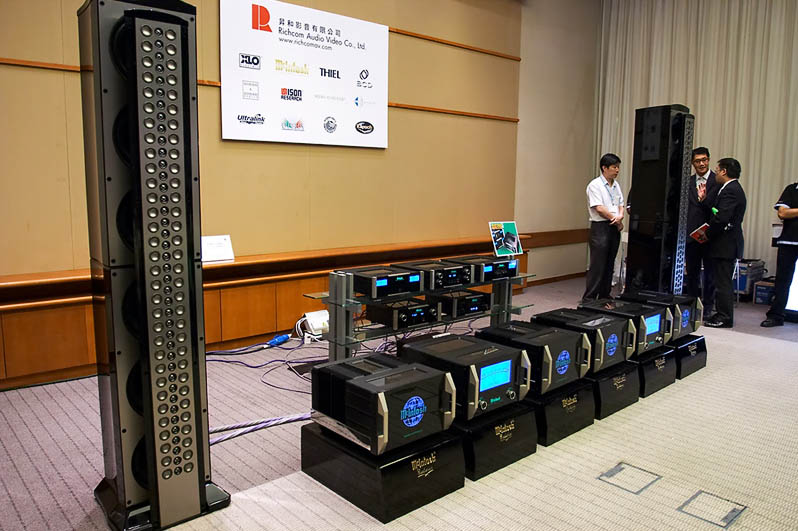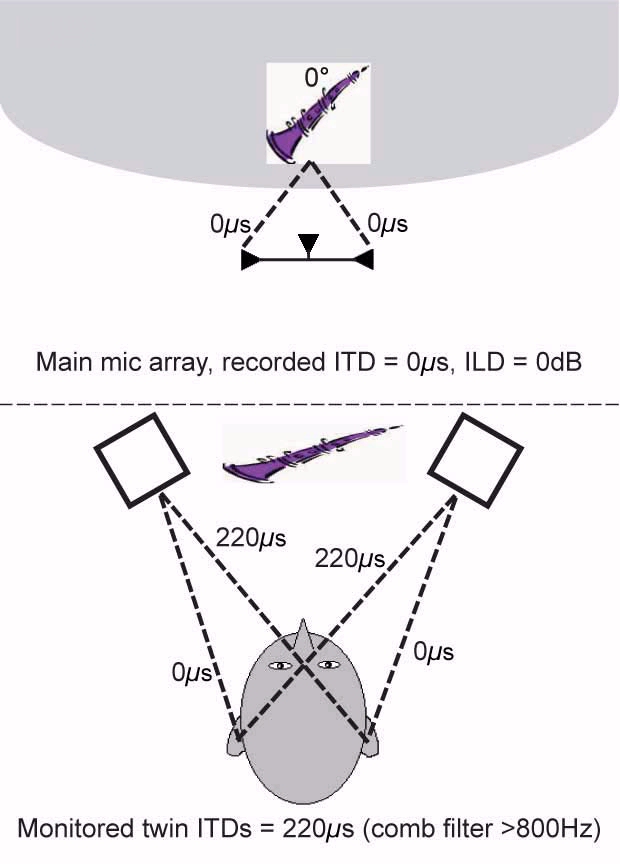Mechanisms
for localisation
It
is important for understanding the workings of
Stereophony that you are convinced that all three
mechanisms are significant and I would suggest, with
Keele, Snow, and Moir, that the Pinnae are first
among equals. You should satisfy yourself on some of
this by running water in a sink to get a nice complex
high frequency source. Close your eyes to avoid bias,
block one ear to reduce ILD and ITD, and see if you
can localize the water sound with just the one open
ear. Point to the sound, open your eyes, and like
most people you will be pointing correctly within a
degree or so. With both ears you should be right on
despite having a signal too high in frequency to have
much ITD or ILD. But with two pinnae agreeing and the
zero ILD clue, the localization is easily accurate.
Again, if a system like stereo or 5.1 cannot deliver,
the ITD, ILD and Pinna cues intact without large
errors it cannot ever deliver full localization
versimilitude for signals like music. If the cues are
inconsistent, localization may occur but it is
fragile, it may vary with the note or instrument
played, and such localization is usually accompanied
by a sense that the music is canned, lacks depth,
presence, etc. Mere localization is no guarantee of
fidelity.
Let us now look at the stereo triangle in
reproduction and the microphones used to make such
recordings and see what happens to the three
localization cues. Basically Stereophonics is an
audible illusion, like an optical illusion. In an
optical illusion the artist uses two dimensional
artistic tricks to stimulate the brain into seeing a
third dimension, something not really there. The
Blumlein stereo illusion is similar in that most
brains perceive a line of sound between two isolated
dots of sound. Like optical illusions, where one is
always aware that they are not real, one would never
confuse the stereophonic illusion with a live
binaural experience. For starters, the placement of
images on the line is nonlinear as a function of ITD
and ILD, and the length of the line is limited to the
angle between the speakers. (I know, everyone,
including Blumlein, has heard sounds beyond the
speakers on occasion but diatribe space is limited.)
I want to get to the ILD/ITD phantom imaging issue
involved in this topic. But let us first get the
pinna issue tucked away. No matter where you locate a
speaker, high frequencies above 1000 Hz can be
detected by the pinna and the location of the speaker
will be pinpointed unless other competing cues
override or confuse this mechanism. In the case of
the stereo triangle the pinna and the ILD/ITD agree
near the location of the speakers. Thus in 5.1 LCR
triple mono sounds fine especially for movie dialog.
In stereo, for central sounds, the pinna angle
impingement error is overridden by the brain because
the ITD and the ILD are consistent with a centered
sound illusion since they are equal at each ear. The
brain also ignores the bogus head shadow since its
coloration and attenuation is symmetrical for central
sources and not large enough to destroy the stereo
sonic illusion. Likewise, the comb-filtering due to
crosstalk, in the pinna frequency region, interferes
with the pinna direction finding facility thus
forcing the brain to rely on the two remaining lower
frequency cues. All these discrepancies are
consciously or subconsciously detected by golden ears
who spend time and treasure striving to eliminate
them and make stereo perfect. Similarly, the urge to
perfect 5.1 is now manifest.
Consider just the three front speakers in 5.1. Unless
we are talking about three channel mono, we really
have two stereo systems side by side. Remember,
stereo is a rather fragile illusion. If you listen to
your standard equilateral stereo system with your
head facing one speaker and the other speaker moved
in 30-degrees, you won't be thrilled. The ILD is
affected since the head shadows are not the same with
one speaker causing virtually no head shadow and the
other a 30 degree one. Similarly the pinna functions
are quite dissimilar. (In the LCR arrangement the
comb-filtering artifacts now are at their worst in
two locations at plus and minus 15-degrees instead of
just around 0-degrees as in stereo) Thus for
equal amplitudes (such as L&C) where a signal is
centered at 15 degrees, as in our little experiment,
the already freakish stereo illusion is badly
strained. Finally, the ITD is still okay and partly
accounts for the fact that despite the center speaker
there is still a sweet spot in almost all home 5.1
systems. Various and quite ingenious 5.1 recording
systems try to compensate for some of these errors
but the results are highly subjective and even
controversial. It is also probably lucky that in 5.1
recording, it is difficult to avoid an ITD since a
coincident main microphone is seldom used in this
environment.
top
|

the real problem, shown in yet
another way...
|




